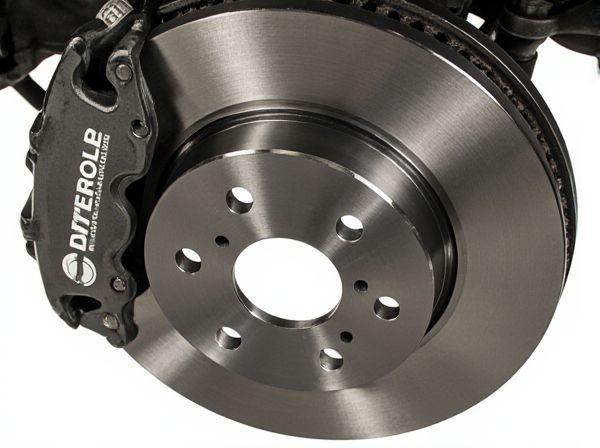
Photo illustration: Composite Rotors vs Iron Rotors
Composite rotors offer enhanced heat dissipation and reduced weight compared to traditional iron rotors, improving braking performance and vehicle efficiency. Iron rotors, while heavier, provide durability and are typically more cost-effective for everyday driving conditions. Choosing the right rotor depends on your driving style and performance needs, with composites favored for high-performance applications and iron rotors for standard use.
Table of Comparison
| Feature | Composite Rotors | Iron Rotors |
|---|---|---|
| Material | Carbon-based composite blend | Cast iron |
| Weight | Lightweight, reduces unsprung mass | Heavier, increases unsprung mass |
| Heat Dissipation | Excellent, resists warping | Good but prone to heat spots |
| Durability | High, resists corrosion and wear | Moderate, susceptible to rust and wear |
| Performance | Superior braking under extreme conditions | Reliable under normal driving |
| Cost | Premium price, higher upfront cost | Affordable, economical choice |
| Lifespan | Longer service life | Shorter service life |
| Common Use | High-performance sports and luxury cars | Standard passenger vehicles |
Introduction to Brake Rotors
Brake rotors, essential components in disc brake systems, influence vehicle stopping performance and heat dissipation. Composite rotors combine materials like carbon composites with metal cores to reduce weight and improve thermal management, enhancing braking efficiency and longevity. Iron rotors, traditionally made from cast iron, offer durability and cost-effectiveness but can be heavier and more prone to heat-induced warping under extreme conditions.
What Are Composite Rotors?
Composite rotors are braking components made from advanced materials such as carbon fiber, ceramics, or a blend of organic compounds, offering lightweight and improved heat dissipation compared to traditional iron rotors. These rotors enhance vehicle performance by reducing unsprung weight and minimizing brake fade during high-stress conditions. Widely used in high-performance and racing vehicles, composite rotors provide superior thermal management and increased durability over standard iron rotors.
Key Features of Iron Rotors
Iron rotors, primarily made from cast iron, offer exceptional durability and heat dissipation, making them a reliable choice for standard braking systems. Their robust construction ensures consistent performance under heavy braking conditions and high temperatures. Compared to composite rotors, iron rotors typically have a longer lifespan but can be heavier, affecting overall vehicle weight and handling.
Performance Comparison
Composite rotors offer superior heat dissipation and reduced weight compared to iron rotors, resulting in enhanced braking performance and improved vehicle handling. Their resistance to corrosion and thermal fatigue ensures consistent stopping power under high-stress conditions, making them ideal for high-performance and racing applications. Iron rotors, while more affordable and durable under general driving conditions, tend to suffer from increased heat retention and quicker wear, which can degrade braking efficiency over time.
Weight and Material Differences
Composite rotors are significantly lighter than iron rotors due to their use of carbon fiber or fiberglass materials, which reduce unsprung weight and improve vehicle handling and fuel efficiency. Iron rotors, made primarily from cast iron, offer superior thermal mass and durability but add considerable weight to the braking system. The weight difference between composite and iron rotors can be substantial, with composite variants often weighing up to 30% less, enhancing performance in high-demand driving conditions.
Durability and Longevity
Composite rotors exhibit superior durability compared to iron rotors due to their resistance to corrosion, heat, and wear, making them ideal for high-performance and long-term use. Iron rotors, while initially robust and less expensive, tend to degrade faster under intense heat cycles, leading to warping and reduced lifespan. The enhanced material properties of composite rotors contribute to extended longevity and consistent braking performance over time.
Heat Dissipation Capabilities
Composite rotors exhibit superior heat dissipation capabilities compared to iron rotors due to their advanced materials that reduce thermal conductivity and increase heat resistance. This improved heat management minimizes brake fade and enhances overall braking performance during high-stress conditions. Iron rotors, while durable and cost-effective, tend to retain more heat, leading to faster temperature buildup and decreased efficiency under repeated braking.
Cost Considerations
Composite rotors generally offer a higher upfront cost compared to iron rotors due to advanced materials like carbon fiber and specialized manufacturing processes. Despite the initial expense, composite rotors provide longer lifespan and reduced wear, potentially lowering replacement and maintenance costs over time. Iron rotors, while more affordable initially, may require more frequent replacements and can incur higher maintenance expenses because of their susceptibility to rust and heat-induced warping.
Applications: When to Use Each Type
Composite rotors excel in high-performance applications such as sports cars and motorcycles, offering superior heat dissipation, reduced weight, and enhanced resistance to warping under extreme braking conditions. Iron rotors, favored in everyday passenger vehicles and heavy-duty trucks, provide durability, cost-effectiveness, and consistent performance under moderate braking loads. Choosing composite rotors suits scenarios demanding lightweight and thermal management, while iron rotors remain ideal for long-lasting reliability in standard driving environments.
Conclusion: Choosing the Right Rotor
Composite rotors offer superior heat dissipation, reduced weight, and enhanced corrosion resistance, making them ideal for high-performance and efficiency-focused vehicles. Iron rotors provide cost-effective durability and better wear resistance under heavy braking conditions, suited for everyday driving and heavy-duty applications. Selecting the right rotor depends on prioritizing factors such as vehicle type, driving habits, and budget constraints to optimize brake performance and longevity.
 caratoz.com
caratoz.com